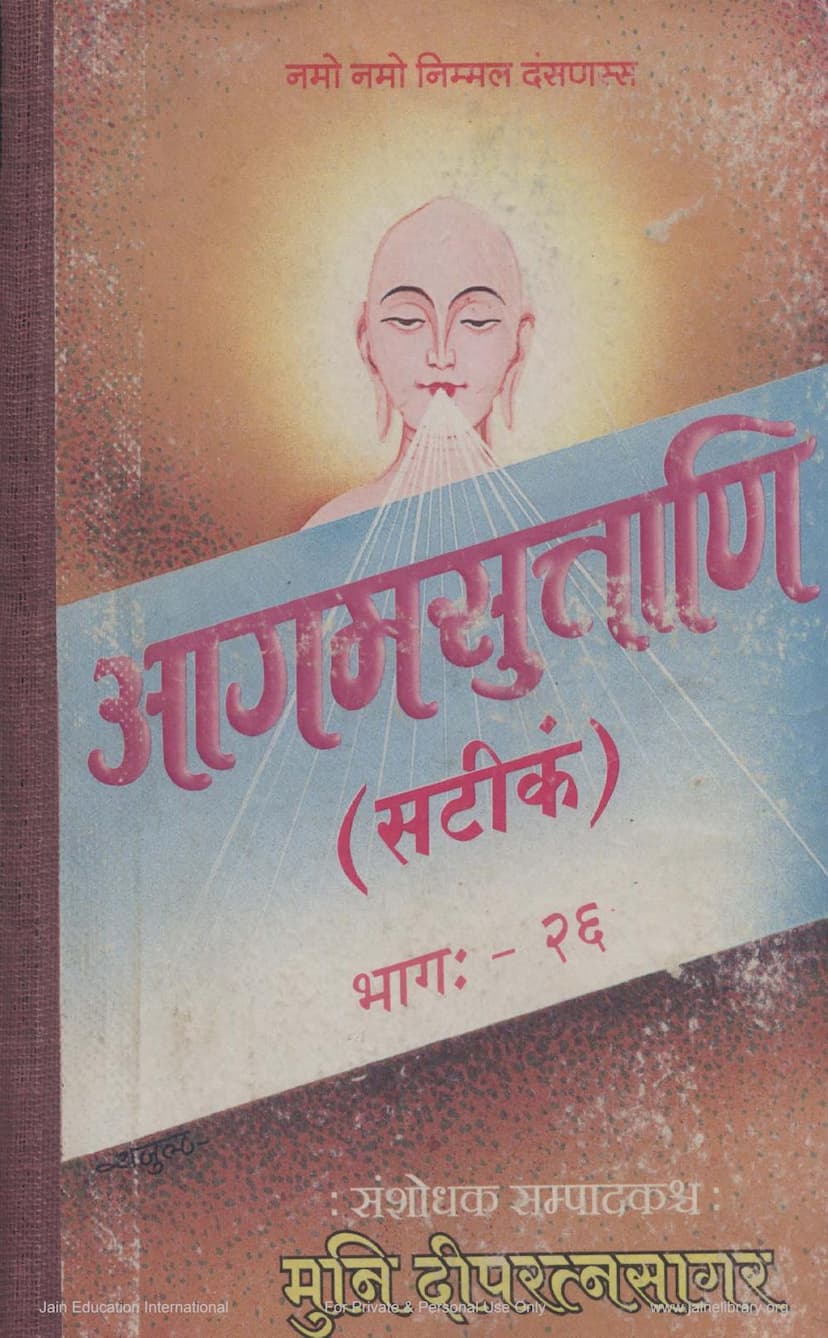Agam Suttani Satikam Part 26 Oghniryukti Pindniryukti
Added to library: September 1, 2025

Summary
This Jain text, "Agam Suttani Satikam Part 26: Oghaniryukti Pindniryukti" by Dipratnasagar and Deepratnasagar, published by Agam Shrut Prakashan, is a significant work within Jain literature, specifically focusing on the detailed explanation of two crucial Niryuktis (commentaries or elucidations) within the Jain Agamas.
Here'S a comprehensive summary of its key aspects:
Core Content:
The book primarily deals with two major Niryuktis:
-
Oghaniryukti (ओघनियुक्ति): This section likely pertains to the Ogha-Niryukti, which is an important commentary on Jain scriptures, particularly the Acharaṅga Sūtra. The Oghaniryukti generally provides a systematic and comprehensive framework for understanding Jain conduct and practices. It often elaborates on the principles of right conduct, ascetic disciplines, and the classification of various aspects of Jainism. The title suggests it might be an extensive commentary, possibly covering eighty-one thousand verses in its entirety, with this volume presenting a portion of it.
-
Pindniryukti (पिण्डनियुक्ति): This section focuses on the Pind-Niryukti, another vital commentary, likely on scriptures related to monastic life and sustenance. The Pind-Niryukti is known for its detailed discussions on:
- Pinda (पिण्ड): This refers to monastic food or sustenance, and its acquisition, acceptance, and consumption.
- Eshana (एषणा): This covers the principles of pure and proper begging or receiving of alms, including the conditions and restrictions for monks and nuns.
- Pramana (प्रमाण): This likely relates to the correct measure or quantity of food and other necessities that monks can possess and consume.
- Upadhi (उपधि): This refers to monastic possessions or requisites, and the rules governing their use and acceptance.
- Niryukti (निर्युक्ति): As mentioned, this refers to the commentary itself, explaining the underlying sutras.
Key Themes and Potential Topics Covered:
Based on the nature of these Niryuktis, the book likely delves into:
- Monastic Conduct (Achara): The Oghaniryukti would systematically explain the various aspects of monastic discipline, including daily routines, ethical principles, and the eradication of karmas.
- Ascetic Practices: Details on penance, fasting, contemplation, and other forms of austerity prescribed for monks and nuns.
- Food and Sustenance (Eshana and Pinda): The Pindniryukti would provide exhaustive details on:
- The sources of food permitted for monks.
- The process of begging for alms (pinda-sweekar).
- The criteria for pure (eshana-suddha) and impure food.
- Rules regarding cooking, serving, and consuming food.
- The proper handling of food remnants and utensils.
- Monastic Possessions (Upadhi): The limitations on a monk's possessions, including clothing, bedding, begging bowls, and other essential items. It would discuss the rules for acquiring, using, and disposing of these items.
- Karma Theory: Both Niryuktis would likely explain how actions related to conduct, sustenance, and possessions affect the accumulation and shedding of karma, a central concept in Jainism.
- Commentarial Interpretation: The work itself, being a Niryukti with a commentary (Satikam), implies a deep dive into the original sutras, clarifying their meaning, intent, and application through verse-by-verse explanation.
- Philosophical and Ethical Foundations: Underlying these practices are the core Jain principles of ahimsa (non-violence), aparigraha (non-possession), anekanta (non-absolutism), and apālagraha (non-attachment), which would be woven into the explanations.
Structure and Presentation:
- Sourced from Agam Shrut Prakashan: The publisher indicates a commitment to preserving and disseminating Jain scriptural knowledge.
- "Satikam" (सटीक): This signifies that the text includes a commentary, making it accessible and providing in-depth explanations of the original verses.
- "Part 26": This suggests the publication is part of a larger series dedicated to Jain Agamas and their commentaries.
- "Mula Suttani": This indicates the text is based on original sutras.
- Comprehensive Index (विषयानुक्रमः): Page 3 provides a detailed index for both Oghaniryukti and Pindniryukti, listing the specific topics (e.g., Mangalam, Pratilekhana Dwaram, Upadhi Pramana Dwaram, Aalochna Dwaram for Oghaniryukti; Pinda, Udgam, Eashana, Sanyojana for Pindniryukti) and their corresponding page numbers. This allows readers to navigate the text efficiently.
- Spiritual Dedications: Pages 4 and 5 show dedications and financial contributors, often inspired by revered Jain Acharyas and Sadhvis. This highlights the collaborative and devotional aspect of bringing such religious literature to the public.
- Authorship: Muni Deepratnasagar is credited as the compiler and editor, indicating a scholarly and dedicated effort in presenting this complex material.
Significance:
This text is invaluable for Jain scholars, monks, nuns, and serious practitioners seeking a thorough understanding of the intricate rules and philosophies governing monastic life, particularly concerning daily conduct, alms-round, possessions, and the detailed practical application of Jain ethics. The commentaries are essential for interpreting the often terse and profound sutras, making this volume a crucial resource for the study of practical Jainism.